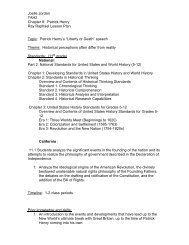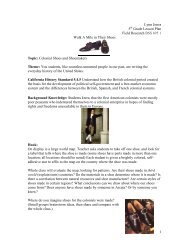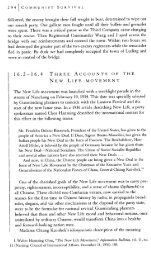Seneca Falls Women's Rights Convention Lesson Plan
Seneca Falls Women's Rights Convention Lesson Plan
Seneca Falls Women's Rights Convention Lesson Plan
Create successful ePaper yourself
Turn your PDF publications into a flip-book with our unique Google optimized e-Paper software.
The <strong>Seneca</strong> <strong>Falls</strong> <strong>Convention</strong> and the Birth of the American Women’s <strong>Rights</strong> MovementTopic: The <strong>Seneca</strong> <strong>Falls</strong> <strong>Convention</strong>, July 13-14, 1848Theme: At <strong>Seneca</strong> <strong>Falls</strong>, women clearly stated they wanted the same rights as men, nothing more,nothing less.Bottom line message: Even though women like Abigail Adams with her admonition not to forgetthe ladies lest they “foment a revolution of their own” and the Englishwoman Mary Wolstonecraftin her Declaration of the <strong>Rights</strong> of Women had called for awareness of and concern for the rights ofwomen, in United States history, it isn’t until the <strong>Seneca</strong> <strong>Falls</strong> <strong>Convention</strong> of 1848 that an Americanstatement of this belief was put forth. This statement, The Declaration of Sentiments, wasintentionally made all the more powerful because it was modeled upon the American civicreligion’s most sacred text, the Declaration of Independence. In the Declaration of Sentiments thecall was clearly made that women wanted the same rights as men, nothing more, nothing less.Bottom line message in one sentence: Women wanted the same rights as men, nothing more,nothing less.Standards Addressed:8.6 Students analyze the divergent paths of the American people from 1800 to the mid-1800sand the challenges they faced, with emphasis on the Northeast.8.6.6. Examine the women's suffrage movement (e.g., biographies, writings, and speeches ofElizabeth Cady Stanton, Margaret Fuller, Lucretia Mott, Susan B. Anthony).11.10 Students analyze the development of federal civil rights and voting rights.11.10.7. Analyze the women's rights movement from the era of Elizabeth Stanton and SusanAnthony and the passage of the Nineteenth Amendment to the movement launched in the 1960s,including differing perspectives on the roles of women.11.5 Students analyze the major political, social, economic, technological, and culturaldevelopments of the 1920s.11.5.4. Analyze the passage of the Nineteenth Amendment and the changing role of women insociety.Length of <strong>Lesson</strong>: Four Days





